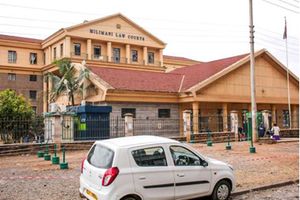
One of the two centre pivot machines at Napuu II Centre Pivot Irrigation Project in Lodwar, Turkana County being implemented by the Kerio Valley Development Authority. The area has an aquifer where water is obtained but currently there are no crops.
Turkana
Premium
Inside plan to drench Turkana
Discovered in 2013 and deemed the miracle Turkana had long waited for, the Napuu water aquifer will now start benefiting residents after a Sh88 million water project was completed in Turkana Central.
The National Water Harvesting and Storage Authority (NWHSA) has handed over the facility, which will benefit more than 25,000 people in several water-stressed villages in Kanam Kemer ward, to the devolved unit.
Deputy Governor Peter Lotethiro said the county is setting up boundaries to secure the aquifer from encroachment.
"We want to protect it from pollution resulting from uncontrolled settlements," Mr Lotethiro said on Friday.

Phillip Ebei Aemun, Turkana County Government’s Chief Executive Committee for Agriculture, during an interview at his office in Lodwar town, Turkana County.
The main 4.6km pipeline from Borehole 4, he said, is connected to a 300,000-litre elevated steel tank in Narewa village from where targeted locals will get water.
He urged locals not to build structures over the pipeline, noting that the county government will invest more funds to pipe water to more residents in the ward.
NWHSA board chairman Andrew Ikenye said that the facility, whose construction began two and a half years ago, was delayed by unavoidable challenges including the Covid-19 pandemic.
"We are glad that the project is completed to solve the perennial water scarcity that has seen many locals get water from River Turkwel while others are forced to spend more on water trucking," Mr Ikenye said.
The Napuu I irrigation scheme in which the county government invested Sh72 million has collapsed, with the gains now just stories that can only be told and not seen.
The fence around the farm has been vandalised, and some of the white tanks deliberately broken down with pipes littering the area.

Abandoned irrigation project: The state of Napuu Irrigation project in Lodwar, Turkana County.
The former farm is now a grazing field for camels, sheep and goats.
Green Prosopis juliflora weed, locally known as mathenge, is evidence of a fertile portion of land begging to be utilised.
Governor Josphat Nanok’s administration had set up five boreholes to be powered by solar energy to irrigate farms so that the county's dream of producing its own ‘fresh’ food would be realised.
Two giant aquifers exist under the desert in Turkana County - Lotikipi and Napuu, which were discovered in 2013.
Lotikipi was estimated to hold 200 billion cubic metres of water, enough to satisfy the needs of Kenya’s population for the next 70 years.
Storage capacity
The discovery of drinkable water would have been life-changing because about 80 percent of people living in Turkana - Kenya’s largest county, which is the size of Rwanda, Burundi and Djibouti combined - do not have access to 50 litres of water a day, an amount that would guarantee “that most basic needs are met”, according to a United Nations report issued at the time.

The Irrigation project in Lodwar has been abandoned.
But a government report from 2015 showed that the water from the aquifer was too saline for human consumption, with mineral levels seven times the accepted limit. This was based on data from one of three wells, and efforts to desalinate it through reverse osmosis are underway.
But the Napuu aquifer, which serves Lodwar town and its environs, is fresh but smaller than Lotikipi.
The aquifer was reported to have storage capacity of about 10 billion cubic metres of water underlying Napuu village near Lodwar town.
In Napuu on Friday, Water Chief Officer Moses Natome said officials are banking on the flagship water project to improve access to potable water.
Mr Natome said the project is already a game changer, especially for residents of Kanam Kemer ward because for the first time Turkana University College, Kanam Kemer Sub-County Hospital and Canaan village will have portable water.
"The county government will lay an additional nine kilometres to cater for more villages. The water will promote development in the real estate sector as well as encourage settlement in villages that had no reliable source of water," he said.
Factions emerged
NWHSA acting chief executive Sharon Obonyo noted that the agency has also invested in flood control at River Kawalase and built several water pans and small dams, including a peace dam in Loima sub-county.
Agriculture executive Philip Aemun and Agriculture Chief Officer Dr Jacob Lolelea said that community leadership wrangles resulted in the collapse of the farming project that propelled the department to acclaim, with many locals, especially in Lodwar town, associating with it to procure fresh vegetables.

Solar panels at Napuu Water Supply Project in Lodwar, Turkana County, which is under the county government. The water is harvested from an aquifer and supplied to surrounding homes.
"The community gave out land and with funds allocated, we successfully set up a drip irrigation scheme and handed it over to the community after we trained the top leadership,” Mr Aemun said.
“An agricultural extension officer was even attached to the project to offer technical support to the farmers.”
He said trouble started when factions emerged and some claimed the scheme was set up on their ancestral land and should be entirely left to them.
“One group literally vandalised the project and destroyed it by cutting the fence, destroying pipes and tanks and even allowed goats to feed on the crops so as to completely chase away unwanted people,” he said.
He said efforts are underway with partners to revive the project, and the groups need to resolve their wrangles.
“We are working with Furrows in the Desert organisation to train beneficiaries on proper governance and also advise them on how to review their constitution for the success of the project," the county official said.
He said the county has 51 irrigation schemes and acreage under irrigation has risen significantly from 9,000 acres to about 50,000.
“Our main focus was to make the county food-secure and thus improve the nutrition of locals. But some of the schemes collapse once they are handed over to the community because of the leadership wrangles which we are now attempting to address,” he said.
Changing locals from pastoralists to agro-pastoralist, he said, has been a challenge, as well as inadequate water.





